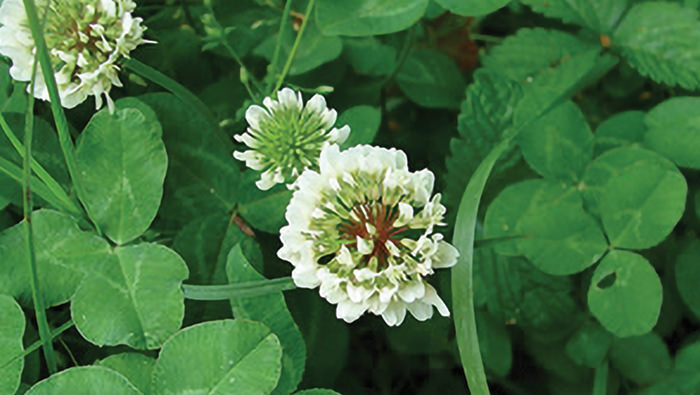
Plant a Living Mulch
Plant a Living Mulch and Never Weed Again (well … almost never).
Many years ago, when I was first growing greens and herbs for restaurants, I was having a difficult time controlling the rabbits who lived in the state forest adjacent to my farm. They loved the tender greens! After trying fences, deterrents, and a motion-detecting water cannon, I finally contacted my local expert. I have realized over the years that no matter how much I’ve learned, the local farmers always have the best advice. He suggested I plant clover around the pond I used for irrigation. According to him, rabbits preferred clover over anything else. That fall I planted my first patch of dwarf white clover, and more the following spring. As that first clover season progressed, I noticed less damage on my crops and fewer rabbits caught behind my fencing. Over the next year I continued to increase the amount of clover around my pond, but I also noticed that the clover was starting to creep into my crop beds. Clover is a great cover crop; it adds organic matter and fixes nitrogen from the air to the soil. But I didn’t want to till my beds every year to control the clover ‘weeds’. I remembered that many ground covers could be used as a ‘living mulch’ to help control weeds. So, I let the cover take over one of the crop beds. It was one of the best decisions I ever made. Within a year the clover had covered the bed and rather than worry about tilling it in each year, I allowed it to flourish. I would cut out a hole or wide row in the clover and plant my seeds or transplants. As the plants grew, the clover would fill in around them. Dwarf white clover is truly short, growing only 4-6” and doesn’t need mowing even when it flowers. It self-seeds, fixes nitrogen to the soil, is relatively free of diseases … AND it suppresses weeds! I did have to water more, not a lot more, but I was watering the clover as well as my crop to keep both healthy. I continued to add compost and an occasional micro-nutrient, but I didn’t notice that the clover pulled any nutrients away from my crops. At the end of each season, I pulled the dead vegetable plants and filled the holes with compost and a little clover seed, but this became unnecessary since clover reseeds readily. The next year most of the open spots were filled in with young clover, but I made new holes for my new transplants. Eventually all my crop beds were covered with a living mulch of dwarf white clover as well as the walking rows between my raised beds. I was even able to take the fencing down around my gardens. Although the ribbits still visited, they absolutely preferred the clover to anything I grew for myself … except for my pea plants! I continued this rotation for 5 years before I moved from that property and have shared this living mulch concept many times.
To grow a living mulch of clover is easy, but there are a few things to consider before you dig right in. First, clover does flower, and bees love clover flowers. If you or someone in your family are allergic to bee stings, clover is probably not a good choice. The other is that it takes about 2 growing seasons for the clover to fill in enough to control weeds. In the beginning you will have to weed between not only your vegetables, but the young clover plants too. The first year, plant your vegetables first and allow them to get established before seeding in clover. Clover seed is tiny and is easier to spread if it’s mixed with fine soil or compost. You will need approximately ¼ pound of clover seed to cover 1000 square feet of garden. Rake the seed in gently and water the seed in. If the soil is at least 60° and is kept moist, germination should begin in less than 10 days. If you prefer to get started in the late summer or fall, make sure the seed will be able to have direct contact with the soil (no mulch or weeds). To survive the winter, clover will need at least 60 days before the first frost to become established. Plan to over-seed at least once in a following season. Clover is a perennial, will also self-seed, and once established requires little maintenance. From then on, the clover will be thick enough to choke out most weeds. Grab a beverage, enjoy an evening walk in the garden and don’t worry about weeding!
